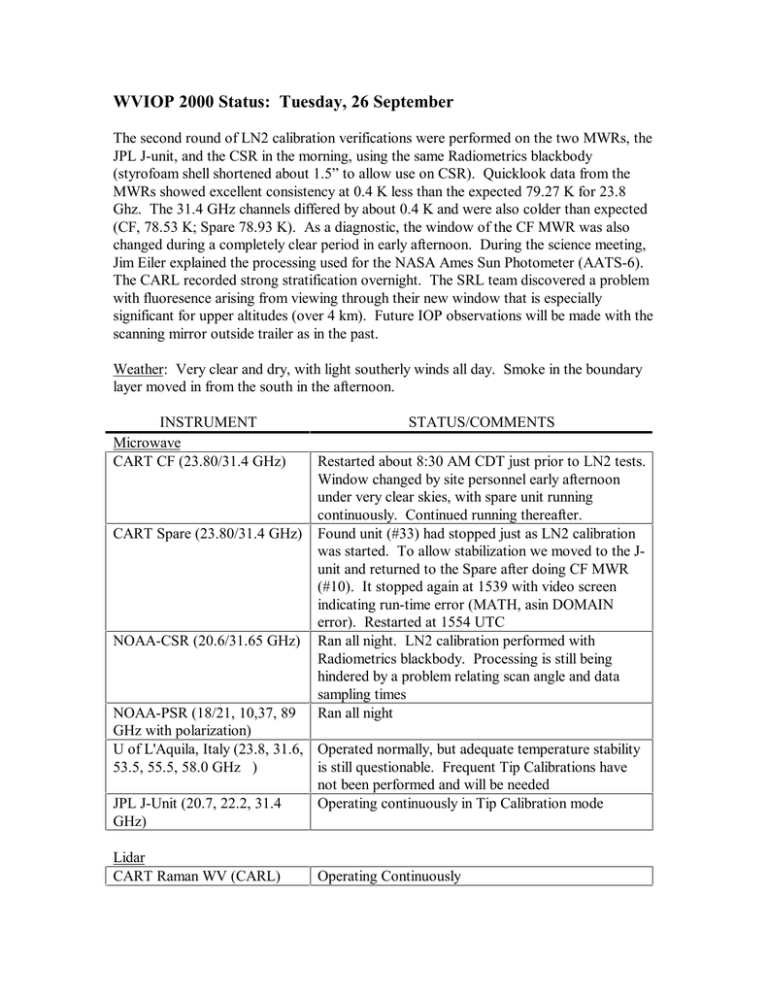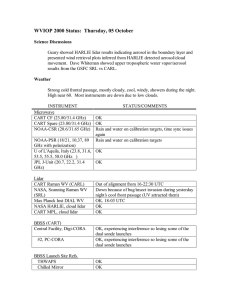WVIOP 2000 Status: Tuesday, 26 September
advertisement

WVIOP 2000 Status: Tuesday, 26 September The second round of LN2 calibration verifications were performed on the two MWRs, the JPL J-unit, and the CSR in the morning, using the same Radiometrics blackbody (styrofoam shell shortened about 1.5” to allow use on CSR). Quicklook data from the MWRs showed excellent consistency at 0.4 K less than the expected 79.27 K for 23.8 Ghz. The 31.4 GHz channels differed by about 0.4 K and were also colder than expected (CF, 78.53 K; Spare 78.93 K). As a diagnostic, the window of the CF MWR was also changed during a completely clear period in early afternoon. During the science meeting, Jim Eiler explained the processing used for the NASA Ames Sun Photometer (AATS-6). The CARL recorded strong stratification overnight. The SRL team discovered a problem with fluoresence arising from viewing through their new window that is especially significant for upper altitudes (over 4 km). Future IOP observations will be made with the scanning mirror outside trailer as in the past. Weather: Very clear and dry, with light southerly winds all day. Smoke in the boundary layer moved in from the south in the afternoon. INSTRUMENT Microwave CART CF (23.80/31.4 GHz) CART Spare (23.80/31.4 GHz) NOAA-CSR (20.6/31.65 GHz) STATUS/COMMENTS Restarted about 8:30 AM CDT just prior to LN2 tests. Window changed by site personnel early afternoon under very clear skies, with spare unit running continuously. Continued running thereafter. Found unit (#33) had stopped just as LN2 calibration was started. To allow stabilization we moved to the Junit and returned to the Spare after doing CF MWR (#10). It stopped again at 1539 with video screen indicating run-time error (MATH, asin DOMAIN error). Restarted at 1554 UTC Ran all night. LN2 calibration performed with Radiometrics blackbody. Processing is still being hindered by a problem relating scan angle and data sampling times Ran all night NOAA-PSR (18/21, 10,37, 89 GHz with polarization) U of L'Aquila, Italy (23.8, 31.6, Operated normally, but adequate temperature stability 53.5, 55.5, 58.0 GHz ) is still questionable. Frequent Tip Calibrations have not been performed and will be needed JPL J-Unit (20.7, 22.2, 31.4 Operating continuously in Tip Calibration mode GHz) Lidar CART Raman WV (CARL) Operating Continuously NASA, Scanning Raman WV (SRL) CART MPL, cloud lidar Operated in automatic scanning mode, with alignment optimized for the vertical. The aerosol channel showed smoke from the afternoon. The lidar works, and the EMI source was identified and removed. Good data was obtained for one hour last night (10:30-11:30 PM CDT). Other problems are being worked. Operated. Resolved minor problem with high altitude (15 km) observations. Observed high thick aerosol layer yesterday and an afternoon smoke event today. Operational BBSS (CART) Cental Facility, Digi-CORA #2, PC-CORA Dual, 3-hourly mode Dual, 3-hourly mode BBSS Launch Site Refs. THWAPS Chilled Mirror Operational. Operational Tower In Situ Sensors CART 60m HMP 35 South,10x CART 60m HMP 35 North CART 25m HMP 35 South,10x CART 25m HMP 35 North Chilled mirror 60m OK MESONET 60m Chilled mirror 25m OK MESONET 25m SMOS (CART) Operational Operational Operational Operational Operational, except data link Operational, except data link Newly installed and Operational, except data link Newly installed and Operational, except data link Operational DataPlane T, RH, P – tower to 1 km Progress, but control problems not yet fixed AERI CART (AERI-01) Prototype (AERI-00) Operational Operated several hours day and night. GPS Central Facility Lamont NOAA Operating normally, expect data this week Operational Sun Photometer/Spectrometer MFRSR N1(CART) Operational Max Planck Inst DIAL WV NASA HARLIE, cloud lidar MFRSR/RSS (Albany) Cimel Sunphotometer NASA AATS-6 channel Operational Operational Operated all day Proteus Aircraft NAST-I NAST-M FIRSC Flights expected to start October 1 Flights expected to start October 1 Not expected to fly Hank Revercomb, University of Wisconsin, IOP Chief Scientist.
